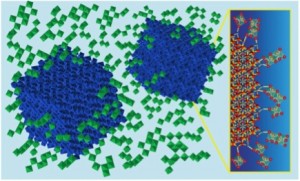It seems to me we may have to find a new way to discuss ‘smart’ windows as there’s only one more category after the comparative ‘smarter’ and that’s the superlative ‘smartest’. Lawrence Berkeley National Laboratory (Berkeley Lab), please, let’s stop the madness now! That said, the Berkeley Lab issued an Aug. 14, 2013 news release (also on EurekAlert) about it’s latest work on raising the IQ of smart windows,
Researchers at the U.S. Department of Energy’s Lawrence Berkeley National Laboratory (Berkeley Lab) have designed a new material to make smart windows even smarter. The material is a thin coating of nanocrystals embedded in glass that can dynamically modify sunlight as it passes through a window. Unlike existing technologies, the coating provides selective control over visible light and heat-producing near-infrared (NIR) light, so windows can maximize both energy savings and occupant comfort in a wide range of climates.
…
Milliron’s research group is already well known for their smart-window technology that blocks NIR without blocking visible light. The technology hinges on an electrochromic effect, where a small jolt of electricity switches the material between NIR-transmitting and NIR-blocking states. This new work takes their approach to the next level by providing independent control over both visible and NIR light. The innovation was recently recognized with a 2013 R&D 100 Award and the researchers are in the early stages of commercializing their technology.
Independent control over NIR light means that occupants can have natural lighting indoors without unwanted thermal gain, reducing the need for both air-conditioning and artificial lighting. The same window can also be switched to a dark mode, blocking both light and heat, or to a bright, fully transparent mode.
“We’re very excited about the combination of unique optical function with the low-cost and environmentally friendly processing technique,” said Llordés, a project scientist working with Milliron. “That’s what turns this ‘universal smart window’ concept into a promising competitive technology.”
Here’s the specific technology that’s been developed, from the news release,
At the heart of their technology is a new “designer” electrochromic material, made from nanocrystals of indium tin oxide embedded in a glassy matrix of niobium oxide. The resulting composite material combines two distinct functionalities—one providing control over visible light and the other, control over NIR—but it is more than the sum of its parts. The researchers found a synergistic interaction in the tiny region where glassy matrix meets nanocrystal that increases the potency of the electrochromic effect, which means they can use thinner coatings without compromising performance. The key is that the way atoms connect across the nanocrystal-glass interface causes a structural rearrangement in the glass matrix. The interaction opens up space inside the glass, allowing charge to move in and out more readily. Beyond electrochromic windows, this discovery suggests new opportunities for battery materials where transport of ions through electrodes can be a challenge.
I notice they’re using indium, one of the ‘rare earths’. Last I heard, China, one of the main sources for ‘rare earths’, was limiting its exports so this seems like an odd choice of material. Perhaps now they’ve proved this can be done, they’ll research for easily available substitutes. Here’s a link to and a citation for the published paper,
Tunable near-infrared and visible-light transmittance in nanocrystal-in-glass composites by Anna Llordés, Guillermo Garcia, Jaume Gazquez, & Delia J. Milliron. Nature 500, 323–326 (15 August 2013) doi:10.1038/nature12398 Published online 14 August 2013
Finally, the researchers have provided an illustration of indium tin oxide nanocrystals,

Nanocrystals of indium tin oxide (shown here in blue) embedded in a glassy matrix of niobium oxide (green) form a composite material that can switch between NIR-transmitting and NIR-blocking states with a small jolt of electricity. A synergistic interaction in the region where glassy matrix meets nanocrystal increases the potency of the electrochromic effect. Courtesy Berkeley Lab